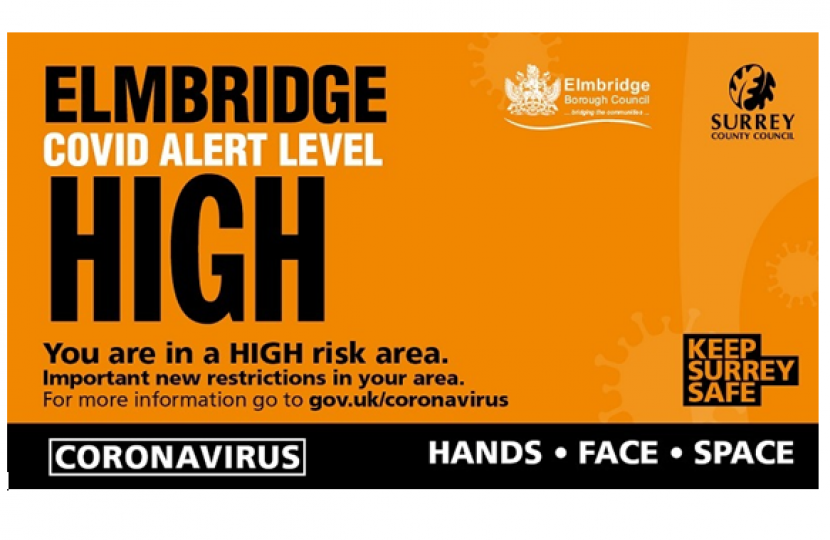
The introduction of Tier 2 restrictions in Elmbridge from Saturday has led to two main questions: What does this mean for us locally, and why has Elmbridge been deemed a high risk area?
The answer to the ‘what’ is available in guidance which I highlighted in response to the announcement last week. This is available here.
The answer to ‘why’ is down to a range of factors. Further data released this week shows the current number of positive cases in Elmbridge is rising rapidly. On 25th September the number of covid cases in Elmbridge, based data from Public Health England, was 30.7 per 100,000 of the population (over the previous 14 days). By 2nd October this had more than tripled to 102 per 100,000. And by 16th October this had more than doubled again to 244.2.
These figures not only show the sharp rise in cases, but also show that Elmbridge is currently the worst affected area of Surrey. The issue here is the rate of growth, and that without moving to Tier 2 we may quickly see large numbers of cases, particularly in the groups most at risk of severe infection and illness.
There has been local speculation that this is being driven by high numbers of cases in students and young people. While this has been the case in other areas, this is not the case in Elmbridge. Data shows cases are spread across demographics with a higher proportion of infections being reported in 40-60 year olds. Factors which determine an area's risk status include the age of people getting ill and susceptibility to the disease, the proportion of tests being done that come back positive and how this is changing, geographic clusters of cases, information gathered through contact tracing, and the potential impact on the NHS.
Elmbridge is now in Tier 2 because covid cases numbers are rising rapidly, the rate of transmission is increasing, and if we don’t take steps to control it, it could threaten our health service’s ability to treat both people with covid and provide other medical and surgical care.
While current hospital admissions at St Peter’s are low, due to rising cases the pressure on our NHS will also increase. For those who get very ill from covid, it takes three weeks on average after contracting covid to get to the point of needing hospital care. Therefore rising rates now will be seen in hospital admissions in three weeks time, and the number of local cases has increased 6-fold in the last 3 weeks. If the rate of infection spirals out of control, then a series of events may be set in motion that lead to even harder and more restrictive lockdown measures.
Restrictions are not a cure for covid. They are a temporary necessity to protect the NHS now. We must control the rate of spread of covid, but at the same time we also need a long-term strategy so we can plan for a future free of the constant threat of further restrictions or lockdown. I know the price of restrictions is high for our residents, our economy, and the many jobs and businesses affected. There are also a range of long-term health costs and restricted access to the NHS, and quite simply – we all want to see our friends and our families!
I am campaigning for a long-term strategy to tackle covid, but right now the situation is that we all have our role to play in controlling the rate of spread of the virus so we can protect our NHS. While restrictions remain I will continue to advocate on behalf of local jobs and businesses, especially those sectors most affected by restrictions. If you are in need of support, please do not hesitate to get in touch.
